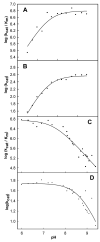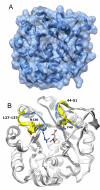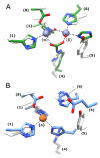Structure and catalytic mechanism of LigI: insight into the amidohydrolase enzymes of cog3618 and lignin degradation
- PMID: 22475079
- PMCID: PMC3416963
- DOI: 10.1021/bi300307b
Structure and catalytic mechanism of LigI: insight into the amidohydrolase enzymes of cog3618 and lignin degradation
Abstract
LigI from Sphingomonas paucimobilis catalyzes the reversible hydrolysis of 2-pyrone-4,6-dicarboxylate (PDC) to 4-oxalomesaconate and 4-carboxy-2-hydroxymuconate in the degradation of lignin. This protein is a member of the amidohydrolase superfamily of enzymes. The protein was expressed in Escherichia coli and then purified to homogeneity. The purified recombinant enzyme does not contain bound metal ions, and the addition of metal chelators or divalent metal ions to the assay mixtures does not affect the rate of product formation. This is the first enzyme from the amidohydrolase superfamily that does not require a divalent metal ion for catalytic activity. The kinetic constants for the hydrolysis of PDC are 340 s(-1) and 9.8 × 10(6) M(-1) s(-1) (k(cat) and k(cat)/K(m), respectively). The pH dependence on the kinetic constants suggests that a single active site residue must be deprotonated for the hydrolysis of PDC. The site of nucleophilic attack was determined by conducting the hydrolysis of PDC in (18)O-labeled water and subsequent (13)C nuclear magnetic resonance analysis. The crystal structures of wild-type LigI and the D248A mutant in the presence of the reaction product were determined to a resolution of 1.9 Å. The C-8 and C-11 carboxylate groups of PDC are coordinated within the active site via ion pair interactions with Arg-130 and Arg-124, respectively. The hydrolytic water molecule is activated by the transfer of a proton to Asp-248. The carbonyl group of the lactone substrate is activated by electrostatic interactions with His-180, His-31, and His-33.
Figures












References
-
- Hishida M, Shikinaka K, Katayama Y, Kajita S, Masai E, Nakamura M, Otsuka Y, Ohara S, Shigehara K. Polyesters of 2-pyrone-4,6-dicarboxylic acid (PDC) as bio-based plastics exhibiting strong adhering properties. Polymer Journal. 2009;41:297–302.
-
- Maruyama K. Purification and properties of 2-pyrone-4,6-dicarboxylate hydrolase. Journal of Biochemistry. 1983;93:557–565. - PubMed
-
- Holm L, Sander C. An Evolutionary Treasure: Unification of a Broad Set of Amidohydrolases Related to Urease. Proteins: Struct., Funct., Genet. 1997;28:72–82. - PubMed
-
- Seibert CM, Raushel FM. Structural and Catalytic Diversity within the Amidohydrolase Superfamily. Biochemistry. 2005;44:6383–6391. - PubMed
MeSH terms
Substances
Associated data
- Actions
- Actions
- Actions
- Actions
Grants and funding
LinkOut - more resources
Full Text Sources
Molecular Biology Databases
Miscellaneous

